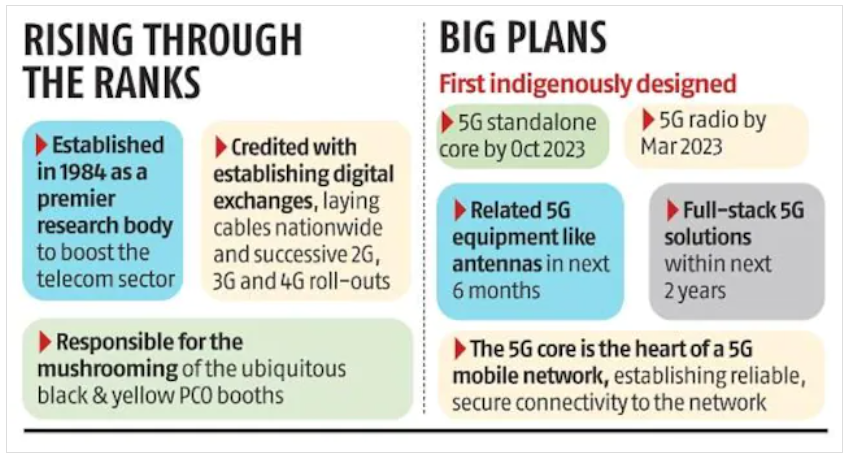ForumIAS announcing GS Foundation Program for UPSC CSE 2025-26 from 27th May. Click Here for more information.
Contents
Source: The post is based on the article “C-DOT emerges as govt’s biggest bet for India’s ongoing 5G rollout” published in the Business Standard on 11th November 2022.
Syllabus: GS 3 – indigenization of technology and developing new technology.
Relevance: About Centre for Development of Telematics (C-DOT).
News: The Centre for Development of Telematics (C-DOT) has emerged as the government’s biggest bet for India’s ongoing 5G rollout.
The Department of Space, the home ministry and other key ministries plan to leverage C-DOT’s capabilities on artificial intelligence, cyber security, optical fibre, machine-to-machine communication, and even reconnaissance.
About Centre for Development of Telematics (C-DOT)
C-DOT was established in 1984 as an autonomous Telecom R&D centre of the Department of Telecommunications. It is a registered society under the Societies Registration Act, 1860.
It is also a registered public-funded research institution with the Department of Scientific and Industrial Research(DSIR), Ministry of Science & Technology, Government of India.
How did C-DOT help in India’s telecom revolution?

C-DOT research has focused on the design and production of ‘Made in India’ telecom technology suited to the Indian landscape. This helped India to a) Set up reliable telecom infrastructure that allowed public call offices or PCOs to mushroom nationwide, b) Establish digital exchanges, c) Create network infrastructure that supported successive waves of 2G, 3G and 4G rollouts and d) Recently, it designed a fully indigenous non-standalone (NSA) 5G core in record time. This NSA core has been installed at the state-owned telecom company, BSNL’s premises in Chandigarh.
Note: The 5G core is the heart of a 5G mobile network. The core domain handles a wide variety of essential functions in the mobile network, such as connectivity and mobility management, authentication and authorisation, subscriber data management and policy management, among others.
As of August 2022, India had 1.17 billion telecom connections, of which 98 per cent were mobile phone connections, and an estimated 65% were smartphones. This phenomenal rise over the past three decades in an economically distressed nation is credited to C-DOT.
Why C-DOT is essential for India’s ongoing 5G rollout?
Development of standalone (SA) 5G core
At present C-DOT is working on the development of India’s first-ever indigenously built standalone (SA) 5G core. It is a technological improvement on the NSA core. The NSA core technology leverages existing networking infrastructure, but the SA core modernises network infrastructure to suit the myriad needs of enterprises.
Need for SA Core: a) The SA core will be necessary for achieving optimal capability in many of the classic use cases of 5G that have been showcased by both the government and industry, b) Only an SA Core can provide a long list of high-tech applications, ranging from robotics, advanced manufacturing and remote surgery, to advanced retail and logistics operations, requires ultra-low latency.
5G radio and antennas
C-DOT is also set to launch the first domestically developed 5G radio and antennas in the next six months.
5G Radio Access Network (RAN)
5G RAN allows the disaggregation of network equipment components, enabling a telecom company to source hardware and software from different vendors for network building.
5G alliances program
Under it, C-DOT has set up 10 consortiums to deliver a complete suite of 5G products by 2024. The focus is on domestic companies from across the value chain. This helps in quickly identifying export opportunities for India’s telecom tech.
| Read more: Telecom secretary asks C-DoT to work on 6G, launches Quantum Communication Lab |
What are the present challenges faced by C-DoT?
Charges of recruiting favourites to crucial posts, and of furnishing false progress reports about C-DoT
a) Commercialising the newly developed technologies remains the bigger challenge, b) Amount of customisation: c) C-DOT’s longtime partner BSNL has often proved to be a problem. BSNL was unhappy with a C-DOT-Tata Group consortium currently working to provide BSNL with 5G equipment because of the higher costs, d) C-DOT often struggled to hire the required number of researchers. Further, researchers often have to get into administrative roles which drains their time.




